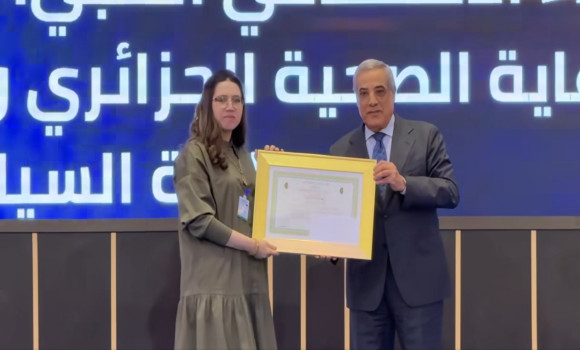News
Dernière mise à jour :
Find here all the news linked to RRI IMPACT (publications, seminars, events, AAP...)
Scientific events
RRI IMPACT Scientific Review, December 11th 2025, IECB, Amphitheater
The IMPACT Impulsion Research Network is pleased to invite you to its scientific review on Thursday 11 December 2025 from 9am to 13pm, followed by lunch.
This morning will take place in the amphitheatre of the IECB, Campus Brus.
The 9 projects funded by IMPACT will present their progress and results. The full programme will be announced shortly.
The event is free and open to all, but registration will be required.
Registration Deadline: December 1st 2025 : https://framaforms.org/rri-impact-scientifc-review-1762350147
Conference - Integrating Microscopy Data with Diffusion MRI Tractography, Charles Poirier (LINUM, University of Sherbrooke), December 4, 2025, 11h, IBIO
Distinction
Amel Imene Hadj Bouzid, winner of the "Prize of the President of the Republic for Innovative Researchers"

Charged by the President of the Republic of Algeria, Mr Abdelmadjid Tebboune, and as part of the activities to commemorate National Student Day, celebrated on 19 May each year, the Algerian Prime Minister, Mr Nadir Larbaoui, together with the Minister of Higher Education and Scientific Research, Mr Kamel Baddari, presided over the award ceremony for the Prize of the President of the Republic for the best student.
On Tuesday 20 May, together with the Minister of Higher Education and Scientific Research, Kamel Baddari, Prime Minister Nadir Larbaoui presided over the award ceremony for the first edition of the President of the Republic's Prize for the Innovative Researcher, at the "Abdelhafid Ihaddaden" science and technology centre in Sidi Abdellah (Algiers).
This prestigious award was delivered to Amel Imene Hadj Bouzid, doctoral student at IMPACT working in WP2 "Cardio-thoracic imaging".
Her research centers on the detection of pulmonary lesions using various imaging techniques, including CT scans and MRI, utilizing deep learning methodologies. The goal of her thesis is to ascertain the severity of lung impairments and to explore the potential for applying these methods across different imaging modalities. Her work is especially significant in the context of emerging treatments, aiming to enhance the precision of diagnosing chronic lung diseases.
Call for projects

No call for the moment.
See you soon!
New publications
Publication - MR Imaging of Pulmonary Surfactant Distribution in
a Preclinical Neonatal Lung Model by Oumaima Marfouk, Ghalia Kaouane, Lara Leclerc, Fanny Munsch, Bei Zhang, Noël Pinaud, Rémy Gérard, Mickaël Fayon, Sophie Périnel-Ragey, Eric Dumas de la Roque, Jérémie Pourchez and Yannick Crémillieux in NMR in Biomedicine.

Abstract
The administration of exogenous surfactant is essential for many premature infants to compensate for pulmonary immaturity and the absence of endogenous surfactant at birth. Exogenous surfactant delivery techniques are continually being refined to improve the management of these infants, with the goal of increasing therapeutic efficacy and decreasing the invasiveness of delivery protocols. Imaging is one of the tools available to achieve these goals. In this study, we established and applied an magnetic resonance imaging (MRI) protocol in a rabbit animal model to determine the intrapulmonary distribution of surfactant solution administered by the clinical reference method. The protocol was applied to an ex vivo model of isolated thorax from non-valued food industry by-products. The protocol made it possible to image surfactant biodistribution with isotropic spatial resolution in the millimeter range, to determine surfactant distribution between the main airways and distal lung regions where alveoli are present using automated segmentation techniques, and to quantitatively map the distribution of the administered surfactant solution.
Publication - Real-time multislice MR-thermometry of the prostate: Assessment of feasibility, accuracy and sources of biases in patients by Marcelin C, Crombé A, Jambon E, Robert G, Bladou F, Bour P, Faller T, Ozenne V, Grenier N, Quesson B. in Diagn Interv Imaging.

Abstract
Purpose: The primary purpose of this study was to evaluate the accuracy of an MR-thermometry sequence for monitoring prostate temperature. The secondary purposes were to analyze clinical and technical factors that may affect accuracy and testing the method in a realistic setting, with MR-guided Laser ablation on an ex vivo muscle sample.
Materials and methods: An ex vivo muscle sample was subjected to Laser ablation while using a two-dimensional multislice segmented echo planar imaging sequence for MR thermometry. The MR thermometry measurements were compared with invasive sensor temperature readings to assess accuracy. Subsequently, 56 men with a median age of 70 years (age range: 53-84 years) who underwent prostate MRI examinations at 1.5- (n = 27) or 3 T (n = 24) were prospectively included. For each patient, the proportion of 'noisy voxels' (i.e., those with a temporal standard deviation of temperature [SD(T)] > 2 °C) in the prostate was calculated. The impact of clinical and technical factors on the proportion of noisy voxels was also examined.
Results: MR-thermometry showed excellent correlation with invasive sensors during MR-guided Laser ablation on the ex vivo muscle sample. The median proportion of noisy voxels per patient in the entire cohort was 1 % (Q1, 0.2; Q3, 4.9; range: 0-90.4). No significant differences in median proportion of noisy voxels were observed between examinations performed at 1.5 T and those at 3 T (P = 0.89 before and after adjustment). No clinical or technical factors significantly influenced the proportion of noisy voxels.
Conclusion: Two-dimensional real time multislice MR-thermometry is feasible and accurate for monitoring prostate temperature in patients.
Keywords: MR-thermometry; Magnetic resonance imaging; Prostate; Prostate cancer; Thermal ablation.
Publication - Positive impact of sodium L-lactate supplementation on blood acid-base status in preterm newborns by Ibrahim, I., Perrot, C., Roumes, H. and al. in Pediatr Res.

Abstract
Background
Preclinical studies indicate that lactate is a crucial cerebral energy substrate, with Na-L-lactate administration significantly reducing brain lesion volumes and improving motor and cognitive functions following neonatal hypoxia-ischemia in rat pups. Its neuroprotective effects are linked to neuronal metabolic utilization, making it a promising candidate for treating newborns with hypoxia-ischemia encephalopathy, a condition where hypothermia remains the only established therapy. However, before initiating a clinical trial, it is necessary to assess the effects of Na-L-lactate infusion on blood parameters.
Methods
We retrospectively analyzed blood parameters in 60 premature neonates during their first days of life. Among them, 30 received Na-L-lactate instead of Na-Cl to prevent hyperchloremic acidosis. Blood pH, lactatemia, bicarbonates, glycemia, natremia, chloremia, base excess, and hemoglobin were monitored before, during, and after Na-L-lactate infusion.
Results
Our findings showed that Na-L-lactate infusion lowered blood lactate levels while increasing pH from 7.25 to 7.31. After stopping the infusion, lactatemia was 1.9 mM, and pH reached 7.32. Na-L-lactate supplementation effectively restored normal blood pH, maintained natremia, and prevented hyperchloremia. Notably, even in cases of high initial lactatemia, lactate levels decreased during the infusion.
Conclusion
Our data are promising and emphasize the need for further research to explore its potential applications in neonatal clinical care.
Impact
-
Sodium L-lactate infusion does not increase blood lactate levels and restores normal pH in premature neonates.
-
The study demonstrates that sodium L-lactate infusion avoids hyperchloremia while maintaining sodium levels, offering a potential alternative to sodium chloride.
-
These findings highlight the need for additional research studies to further evaluate the safety, efficacy, and potential applications of sodium L-lactate infusion in neonatal care.
Publication - Lifespan Tree of Brain Anatomy: Diagnostic Values for Motor and Cognitive Neurodegenerative Diseases by Pierrick Coupé, Boris Mansencal, José V. Manjón, Patrice Péran, Wassilios G. Meissner, Thomas Tourdias, Vincent Planche, Human Brain Mapping



